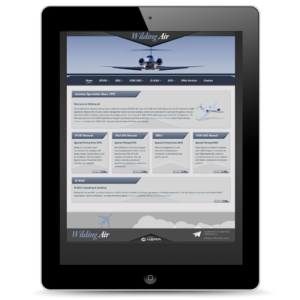iPad EFB FAQ
What is an EFB (Electronic Flight Bag)?
An EFB is any device, or combination of devices, actively displaying applications and are characterized by the following:
- An EFB hosts applications, which are generally replacing conventional paper products and tools, traditionally carried in the pilot’s flight bag or located within the flight deck. Applications include natural extensions of traditional flight bag or flight deck contents, such as replacing paper copies of weather with access to near-real-time weather information.
- In order to qualify as an EFB application, the failure effect must be considered a minor hazard or have no safety effect.
- EFBs cannot replace any installed equipment required by operational or airworthiness regulations.
- Applications have no certification requirements for installation under aircraft type design (refer to FAA AC 20-173).
What are the requirements for displaying EFB own-ship position?
You may overlay own-ship position on an EFB only when the installed primary flight display, weather display, or map display also depict own-ship position. For installed EFB displays, refer to FAA AC 20-173 for additional guidance.
What are the different types of EFB applications?
EFB applications are categorized as either Type A or B, and can be hosted on either portable or installed components / hardware.
Type A Applications:
- Have a failure condition classification considered to be no safety effect.
- Do not substitute for or replace any paper, system, or equipment required by airworthiness or operational regulations.
- Do not require specific authorization for use (i.e., although the Type A Application is part of the Operator’s EFB program, Type A Applications are not identified or controlled in the Operator’s Op Specs or Management Specifications (MSpecs)).
- Examples of Type A Applications include aircraft parts manuals, VOR checks, MELs, CDLs, NEFs, federal or state regulations, chart supplements, noise abatement procedures, IOMs, AIPs, AIMs, flight and duty time logs.
- A complete list of Type A Applications is located within FAA AC 120-76D, Appendix A.
Type B Applications:
- Have a failure condition classification considered minor.
- May substitute or replace paper products of information required for dispatch or to be carried in the aircraft.
- May not substitute for or replace any installed equipment required by airworthiness or operating regulations.
- Require specific authorization for operational authorization for use (i.e., each Type B Application must be authorized by the FAA in the Operator’s Op Specs or MSpecs).
- Examples of Type B Applications include AFMs, POHs, FOMs, GOMs, maintenance manuals, SOPs, weight and balance data, aircraft performance data, master flight plans, weather and aeronautical information, electronic checklists and aeronautical charts (i.e. arrival, departure, en route, area, approach and airport charts).
- A complete list of Type B Applications is located within FAA AC 120-76D, Appendix B.
FAA Advisory Circular 120-76D (Authorization for Use of Electronic Flight Bags)
